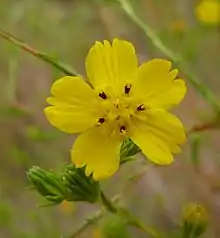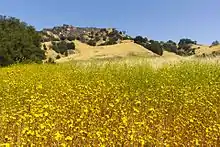Deinandra fasciculata
Deinandra fasciculata (syn: Hemizonia fasciculata), known by the common names clustered tarweed[1] and fascicled spikeweed,[2] is a species of flowering plant in the daisy family native to western North America.[3]
| Deinandra fasciculata | |
|---|---|
 | |
| Scientific classification | |
| Kingdom: | |
| (unranked): | |
| (unranked): | |
| (unranked): | |
| Order: | |
| Family: | |
| Subfamily: | |
| Tribe: | |
| Genus: | |
| Species: | D. fasciculata |
| Binomial name | |
| Deinandra fasciculata | |
| Synonyms | |
| |
Range
Deinandra fasciculata is native to Baja California and California (primarily from San Diego County to Monterey County, including several of the Channel Islands; Calflora reports a few collections from the San Francisco Bay area, but these are from urban areas and probably represent cultivated specimens).[4] It is a common member of coastal grassland habitats in the California chaparral and woodlands ecoregion and other habitats.[3]
Description
Deinandra fasciculata is a thin-stemmed branched annual herb growing erect up to 100 cm (40 inches) in height. The upper leaves are narrow, about 1 centimeter long nested against the stem (more like short needles than leaves). The lower leaves are much bigger, up to 15 centimeters (6 inches) long.[5]
Each flower head has a center of six yellowish disc florets with black stamens surrounded by five yellow ray florets. The ray florets generally have three teeth, the central tooth being the smallest.[3] Plants flower in May through October.[4]
In this genus the disk flowers are actually big enough to be seen as tiny flowers to the naked eye.

The plant has a tar-like smell.[6]
Ecology
Deinandra fasciculata is pollinated by bees, and the seeds are primarily gravity-dispersed (they fall from the seed heads when mature). Seeds may also be dispersed by the many bird and small mammal species which eat them.[6][7]
This species may hybridize with other members of its genus, as well as with Hemizonia and Centromadia species.[6]
See also
- California coastal prairie
- Natural history of the California chaparral and woodlands
- Deinandra — current genus
- Hemizonia — former genus
References
- "Hemizonia fasciculata". Natural Resources Conservation Service PLANTS Database. USDA. Retrieved 20 January 2016.
- "BSBI List 2007". Botanical Society of Britain and Ireland. Archived from the original (xls) on 2015-01-25. Retrieved 2014-10-17.
- Jepson eFlora: Hemizonia fasciculata . accessed 4.16.2015
- Calflora taxon report, University of California, Deinandra fasciculata (DC.) Greene, Clustered tarweed
- Flora of California, Deinandra fasciculata (de Candolle) Greene, Fl. Francisc. 4: 424. 1897.
- Montalvo, A. M.; L. H. Goode & J. L. Beyers (2010). "Plant Profile for Deinandra fasciculata" (PDF). Retrieved 16 June 2017.
- "Plants Profile for Hemizonia fasciculata (clustered tarweed)". plants.usda.gov. Retrieved 2017-06-16.
External links
| Wikimedia Commons has media related to Deinandra fasciculata. |